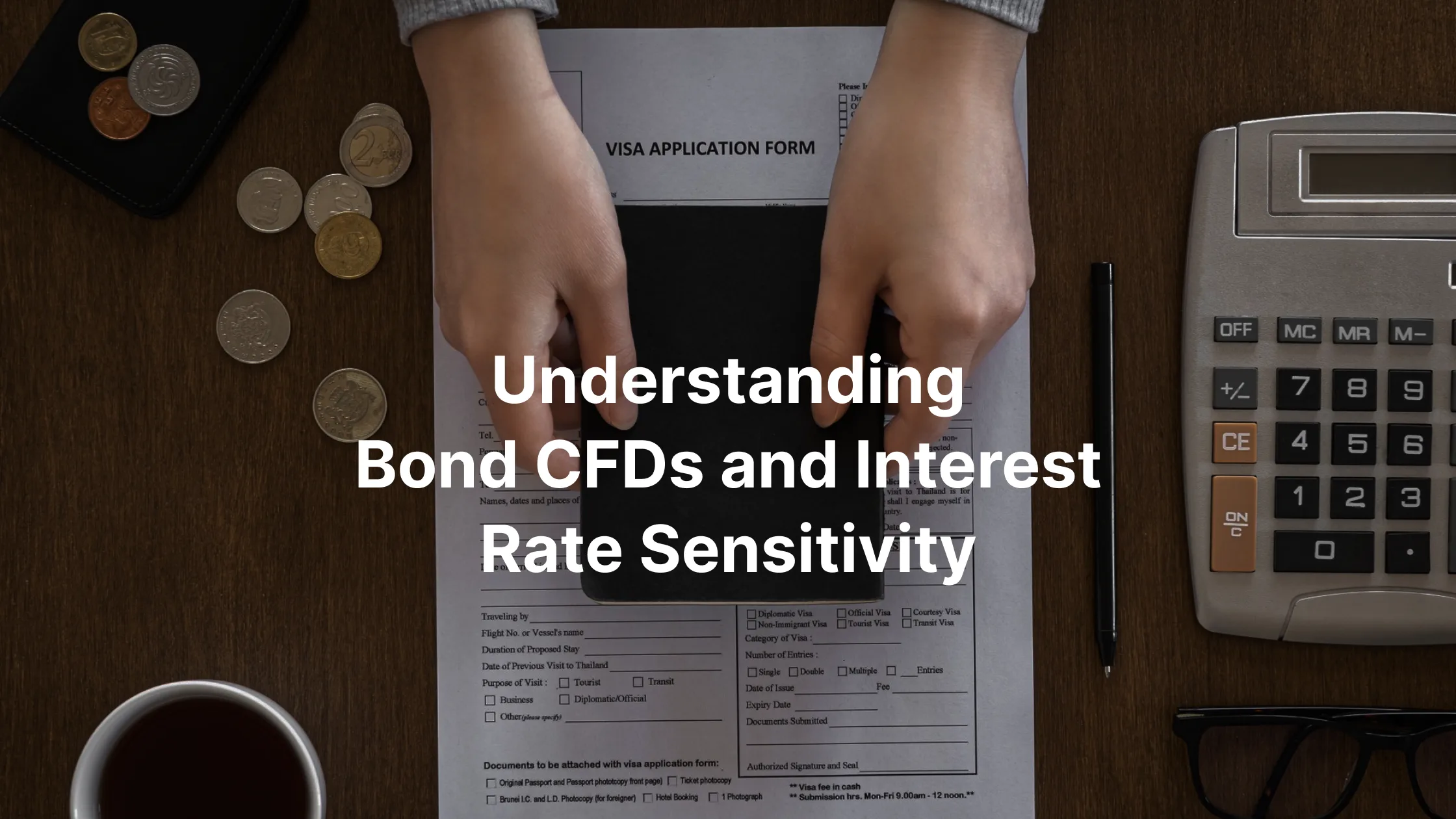
債券差價合約(CFD)是一種複雜的金融工具,對尋求槓桿投資債券價格變動的投資者有吸引力。它們的價值直接受到利率變化的影響,使得利率敏感度成為市場參與者的關鍵因素。本文深入探討了債券差價合約的運作方式以及為什麼了解利率敏感性對於高淨值投資者至關重要。
什麼是債券差價合約?
債券差價合約 允許投資者在不擁有實際證券的情況下推測基礎債券的價格變動。它們是衍生性工具,買方和賣方同意交換合約開盤和平倉期間債券價值的差額。
這些合約提供靈活性和槓桿作用,使投資者能夠持有多頭或空頭部位。例如,如果您預期債券價格會因利率下降而上漲,您可以持有多頭部位。相反,當利率預期上升時,空頭部位受益於債券價格下跌。
債券差價合約的主要特點:
- 槓桿作用: 較小的初始保證金會帶來較大的債券部位風險,從而放大潛在回報(和風險)。
- 流動性: 債券差價合約通常具有高流動性,確保輕鬆進出部位。
- 輔助功能: 投資者可以交易全球市場的債券,而無需處理擁有實體債券的複雜性。
債券差價合約與傳統債券投資有何不同
與傳統債券不同,傳統債券投資者賺取利息收入(息票)並在到期時獲得面值, 債券差價合約純粹關注價格變動。不涉及息票支付或本金償還。
例如,傳統投資者可能會持有政府債券至到期以獲得定期利息,而差價合約投資者則根據債券的市場價格上漲或下跌進行交易。這種區別使差價合約成為那些尋求短期機會而不是長期穩定性的人的理想選擇。

利率在債券定價中的作用
要了解債券差價合約的利率敏感性,必須先了解利率如何影響債券價格。債券和利率成反比關係:
- 當利率上升時,債券價格下跌。
- 當利率下降時,債券價格會上漲。
造成這種反比關係的原因是,當新債券提供更高的收益率時,以較低利率發行的債券的吸引力就會降低。投資者要求對舊債券進行折扣,以使其有效收益率與當前利率保持一致。
債券差價合約的利率敏感性
利率敏感度衡量債券價格因利率變動而變動的程度。此靈敏度通常表示為 期間 或者 修改的持續時間,這是債券差價合約投資者的重要指標。
- 期間: 衡量債券價格波動性的指標。久期越長,債券對利率變動越敏感。
- 修改持續時間: 調整久期計算以反映收益率的變化,提供更精確的敏感性指標。
為什麼這對債券差價合約很重要?
在差價合約交易中,升息可能會顯著影響與高敏感度債券相關的部位。高淨值投資者必須考慮到這種敏感性才能有效管理風險。
例:利率對債券差價合約的影響
考慮基於期限為 10 年且久期為 8 年的政府債券的差價合約。如果利率增加 1%,則債券價格預計將下跌約 8%。對於差價合約交易者來說,這意味著成比例的損失(如果做空則獲得收益)。
這個例子強調了追蹤央行政策和市場預測以預測利率變化的必要性。
債券差價合約對高淨值投資者的優勢
債券差價合約 具有吸引經驗豐富的投資者的多項優勢:
- 投資組合多元化: 債券的表現通常與股票不同,可以對沖股市波動。
- 靈活性: 做多或做空的能力使投資者能夠在利率上升和下降的環境中獲利。
- 槓桿作用: 最大限度地提高資本效率,以最少的前期投資實現更大的頭寸。
然而,槓桿也會放大風險,因此適當的風險管理至關重要
與債券差價合約相關的風險
儘管有好處,債券差價合約並非沒有風險:
- 槓桿風險: 放大利潤和損失,可能導致嚴重的資本侵蝕。
- 市場風險: 突然的利率變化或意外的經濟數據可能導致價格快速波動。
- 交易對手風險: 由於差價合約是場外交易產品,其價值取決於經紀商的可靠性。
高淨值投資者必須進行盡職調查並選擇信譽良好的經紀人來降低這些風險。
管理利率敏感度的策略

有效的管理策略 利率敏感度 包括:
- 對沖: 使用利率掉期或選擇權來抵銷潛在損失。
- 時長調整: 重點關注期限較短的債券,這些債券對利率變化較不敏感。
- 多樣化: 將投資分散到不同期限和市場,以減少單一利率環境的風險。
宏觀經濟因素如何影響債券差價合約
多個宏觀經濟因素影響債券價格,進而影響債券差價合約:
- 央行政策: 聯準會或歐洲央行等機構的利率決策直接影響債券估值。
- 通膨預期: 通膨上升通常會導致利率上升,從而導致債券價格下降。
- 經濟成長: 強勁成長可能導致利率上升,而經濟放緩可能導致降息。
投資人必須隨時了解這些因素,以預測潛在的市場趨勢。
為您的投資組合選擇合適的債券差價合約
選擇債券差價合約時,請考慮以下因素:
- 基礎債券類型: 政府公債的波動性通常低於公司債。
- 期間: 選擇期限與您的利率前景相符的債券。
- 經紀商選擇: 擁有透明定價和強大風險管理工具的信譽良好的經紀商至關重要。
利率不確定性下債券差價合約的未來
隨著各國央行採取不同的策略來應對通膨和經濟成長,利率波動可能會持續下去。這種環境為熟練的債券差價合約交易者提供了利用價格波動的機會。
投資者應採取前瞻性方法,利用分析和見解來預測利率變化並相應地定位自己。

